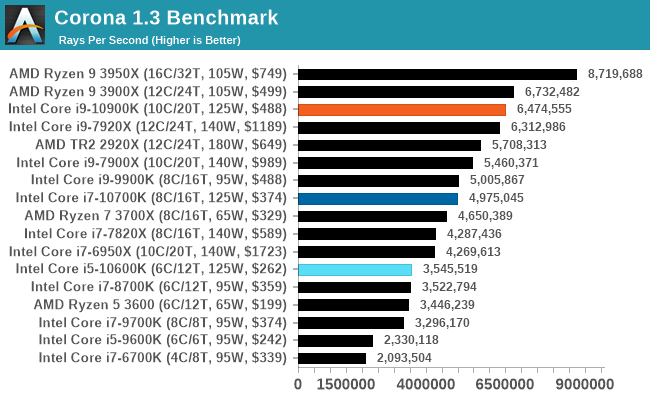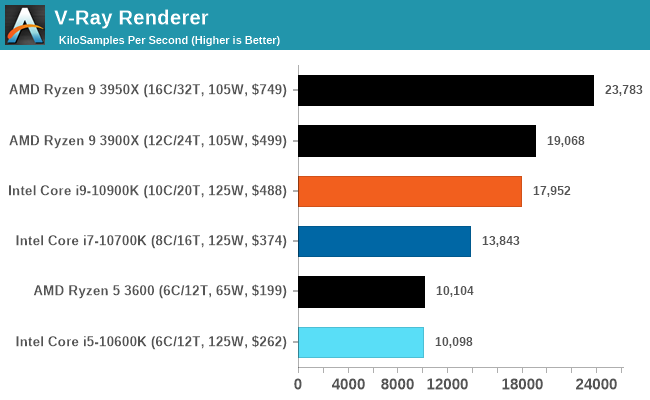The Intel Comet Lake Core i9-10900K, i7-10700K, i5-10600K CPU Review: Skylake We Go Again
by Dr. Ian Cutress on May 20, 2020 9:00 AM EST- Posted in
- CPUs
- Intel
- Skylake
- 14nm
- Z490
- 10th Gen Core
- Comet Lake
CPU Performance: Rendering Tests
Rendering is often a key target for processor workloads, lending itself to a professional environment. It comes in different formats as well, from 3D rendering through rasterization, such as games, or by ray tracing, and invokes the ability of the software to manage meshes, textures, collisions, aliasing, physics (in animations), and discarding unnecessary work. Most renderers offer CPU code paths, while a few use GPUs and select environments use FPGAs or dedicated ASICs. For big studios however, CPUs are still the hardware of choice.
All of our benchmark results can also be found in our benchmark engine, Bench.
Crysis CPU Render
One of the most oft used memes in computer gaming is ‘Can It Run Crysis?’. The original 2007 game, built in the Crytek engine by Crytek, was heralded as a computationally complex title for the hardware at the time and several years after, suggesting that a user needed graphics hardware from the future in order to run it. Fast forward over a decade, and the game runs fairly easily on modern GPUs, but we can also apply the same concept to pure CPU rendering – can the CPU render Crysis? Since 64 core processors entered the market, one can dream. We built a benchmark to see whether the hardware can.
For this test, we’re running Crysis’ own GPU benchmark, but in CPU render mode. This is a 2000 frame test, which we run over a series of resolutions from 800x600 up to 1920x1080. For simplicity, we provide the 1080p test here.
This is one of our new benchmarks, so we are slowly building up the database as we start regression testing older processors.

The Core i9-10900K scores 15 FPS at 800x600, which is just about playable.
Corona 1.3: Performance Render
An advanced performance based renderer for software such as 3ds Max and Cinema 4D, the Corona benchmark renders a generated scene as a standard under its 1.3 software version. Normally the GUI implementation of the benchmark shows the scene being built, and allows the user to upload the result as a ‘time to complete’.
We got in contact with the developer who gave us a command line version of the benchmark that does a direct output of results. Rather than reporting time, we report the average number of rays per second across six runs, as the performance scaling of a result per unit time is typically visually easier to understand.
The Corona benchmark website can be found at https://corona-renderer.com/benchmark

Blender 2.79b: 3D Creation Suite
A high profile rendering tool, Blender is open-source allowing for massive amounts of configurability, and is used by a number of high-profile animation studios worldwide. The organization recently released a Blender benchmark package, a couple of weeks after we had narrowed our Blender test for our new suite, however their test can take over an hour. For our results, we run one of the sub-tests in that suite through the command line - a standard ‘bmw27’ scene in CPU only mode, and measure the time to complete the render.
Blender can be downloaded at https://www.blender.org/download/

V-Ray
We have a couple of renderers and ray tracers in our suite already, however V-Ray’s benchmark came through for a requested benchmark enough for us to roll it into our suite. We run the standard standalone benchmark application, but in an automated fashion to pull out the result in the form of kilosamples/second. We run the test six times and take an average of the valid results.
This is another one of our recently added tests.

POV-Ray 3.7.1: Ray Tracing
The Persistence of Vision ray tracing engine is another well-known benchmarking tool, which was in a state of relative hibernation until AMD released its Zen processors, to which suddenly both Intel and AMD were submitting code to the main branch of the open source project. For our test, we use the built-in benchmark for all-cores, called from the command line.
POV-Ray can be downloaded from http://www.povray.org/

Interestingly the Core i9 with only 10C outperforms the 12C Ryzen 9 3900X here, likely due to the higher sustained frequency of the Intel chip. We clocked 220W on our Intel chip for this test however, well beyond the 120W of the AMD processor.












220 Comments
View All Comments
Spunjji - Tuesday, May 26, 2020 - link
Complaining at the reviewer for failing to test something that doesn't really get used is... a thing.Datawhite - Thursday, May 21, 2020 - link
Bring on ZEN 3 AMD than Intel can R.I.P. ......Still waiting for RDNA 2!
Samus - Thursday, May 21, 2020 - link
No quad core under $100 basically just gave AMD the entire budget segment.Overall, this pricing is ridiculous but at least the 6C parts are somewhat competitive.
ph1nn - Thursday, May 21, 2020 - link
Does Intel realize global climate change is a thing? This power consumption is an embarrassment, this company used to have the most most efficient CPUs now they draw 200W?!Gastec - Friday, May 22, 2020 - link
I don't understand what the climate change has to do with a 200W CPU power consumption. I would have understood something like "does Intel realize we have limited or non-existent incomes, given the current Pandemic situation?"Beaver M. - Friday, May 22, 2020 - link
I hope you buy a new PC only every 10 years.pegnose - Friday, May 22, 2020 - link
It looks to me that a simple re-ordering of the core-to-core latency chart for the 10900K removes the apparent 3-4 ns jump. You already mentioned that the core "names" not necessarily represent hardware positions, Ian.Btw, I am curious why it seems that a higher core/thread index comes with higher latency. Adjacent cores should have low core-to-core latency. But 16-to-18 takes longer than 4-to-6. Is this due to address-checking in the ring-bus communication taking longer for higher indices?
Shaquille_Oatmeal - Friday, May 22, 2020 - link
X570 chipset AMD boards can't be found in stock almost anywhere. This isn't news. But even today, days after Intel's 10th gen LGA1200 CPUs launched, and the arguably subjective reviews are finally made public, there's an endless supply of Z490 boards. PC enthusiasts do want the fastest CPUs, for sure, but we also consider the cost and [overall efficiency]. We are not 12 year old kids wanting the colorful RGB lights for our COD rig. No. The RGB lighting is a nice feature, but we're not idiots. These Intel CPUs are garbage based on even Intel's standards over the years; yet they are being marketed like they are the best CPUs. Intel, we can see the truth. And the truth is we won't touch these CPUs; perhaps if you dropped the price on the 10700K to $250 we can have a serious convo. Hopefully Intel gets there game together. I'm sure their OEM buyers are thinking the same.Gastec - Friday, May 22, 2020 - link
The way this is going I'm looking forward to that 32-core Intel consumer CPU, with 1000 W power draw, that will definitely give us those much needed 1000 fps @ 1080pboozed - Saturday, May 23, 2020 - link
Got a question about the game benchmarks. The table has an "IGP" column but the charts in that column have "GTX 1080" written on them. So which is it?